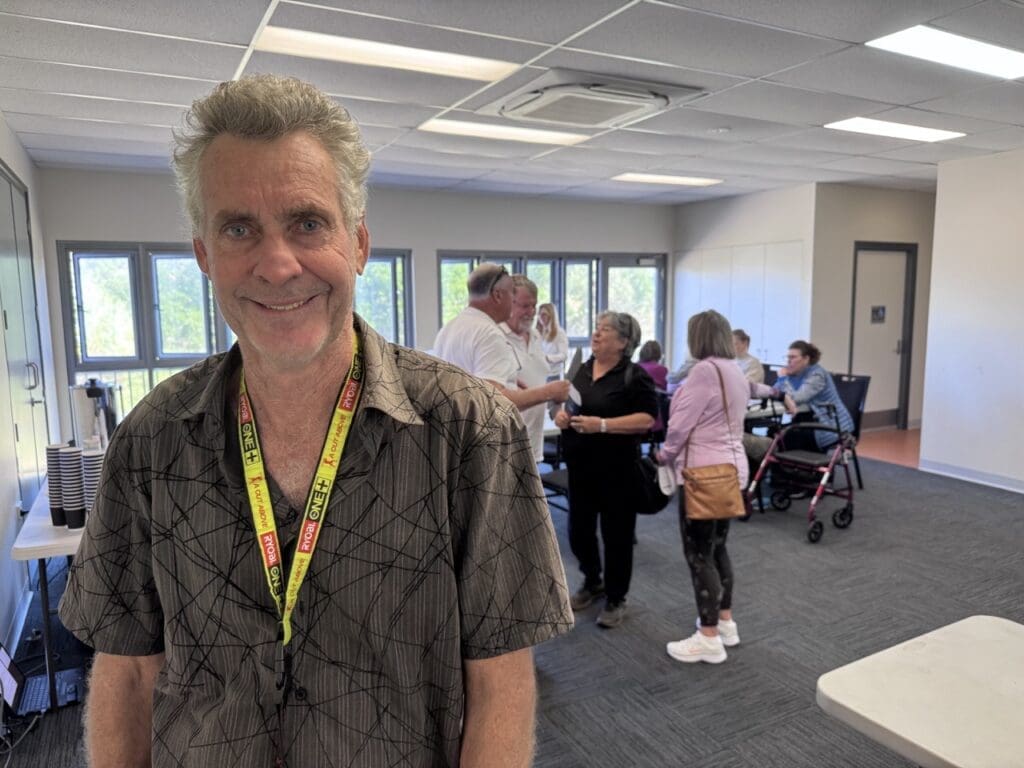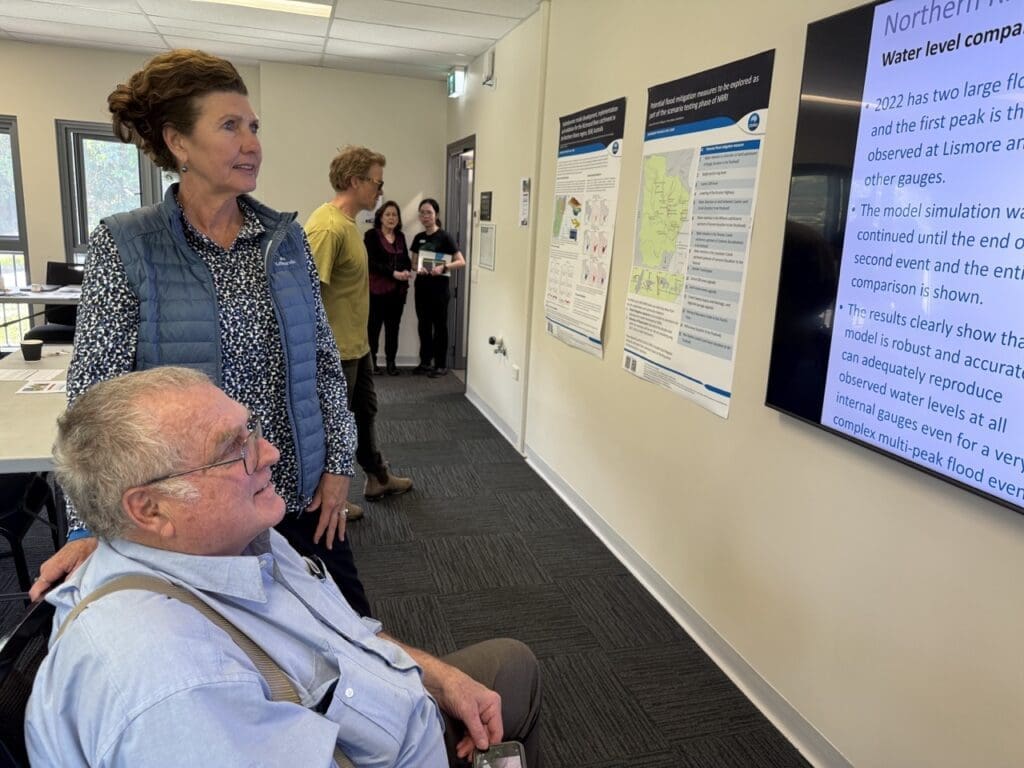The CSIRO’s flood mitigation experts came to Ballina yesterday to hear from the community on the regional flood modelling project.
While a list of 15 shortlisted projects drawn up after the 2022 flood disaster were the starting point for discussion, locals brought a few of their own priorities to the table.
High on the agenda at the well-attended Ballina session were local drainage issues, concerns about the impact of the upgraded Pacific Highway, and calls to resume dredging of the Richmond River.
Dr Jai Vaze, Senior Principal Research Scientist at the CSIRO and lead modeller on the project, said the session had prompted a thoughtful and informed discussion.
“I was surprised by how knowledgeable many people are,” Dr Vaze said. “I’ve found Ballina people to be really positive and they came with very logical solutions.”
He said most attendees did not support the construction of a levee around Ballina, citing concerns about cost, aesthetics, and the potential for floodwaters to be displaced into other areas.
“When I asked whether people wanted a levee if water levels could be reduced upstream, they said no. If we can stop the water reaching Ballina, that’s the solution.”
Dr Vaze noted that solving upstream issues should also help improve local drainage by reducing the load on the system.
He acknowledged that Ballina’s low-lying geography leaves it vulnerable to sea level rise — an issue beyond the scope of the current flood mitigation modelling — but said it was an ongoing concern.
Highway impact raises eyebrows
One of the most contentious topics raised by residents was the role of the new Pacific Highway in worsening flooding west of Ballina.
South Ballina resident Dave Felsch said locals the elevated highway acts as a barrier, pushing floodwaters back into floodplain communities.
“I asked why the model doesn’t include the highway as a variable,” Mr Felsch said. “The response was that because there’s a court case pending, they can’t really talk about it.”
Mayor Sharon Cadwallader, who attended the Ballina briefing, confirmed she had also raised the issue early in the process.
“I was told the highway was built to one-in-100-year flood modelling, not a one-off catastrophic event. But it’s something residents have been calling for more investigation into.”

Calls for dredging — but scientists cautious
Another hot topic was dredging — a legacy flood management tool many residents believe should return.
Mr Felsch said the river’s natural flow had been restricted by years of neglect, contributing to erosion and high water levels in areas like Burns Point Ferry Road and River Drive.
“It’s not just about floods — dredging supports fish habitat, boating access, and water quality,” he said.
Dr Vaze said dredging was not originally one of the shortlisted options, but could still be included if the community deemed it a priority.
“We can model it, but it takes time — around four months to add it as a scenario. It may help slightly during a flood, but it could also increase saltwater intrusion during low flows. We need to test it.”
He stressed that any new scenario added would mean another would likely need to be dropped.
What’s next
Dr Vaze said the CSIRO team will now finalise two to three “bundles” of measures to model, based on this round of consultation.
Once the scenarios are tested, a final round of engagement with councils and the community will take place before recommendations are submitted in mid-2026.
“It’s a tight timeline,” he said. “But we’re here to listen. If dredging or highway impact are seen as crucial, we’ll do our best to factor them in.”
While CSIRO’s consultation process is focused on identifying practical, model-tested solutions, there’s a growing divergence of opinion within the community about the best path forward.

Emerging Divide
Federal Member for Page Kevin Hogan presented a petition signed by more than 2,000 locals during CSIRO’s Lismore consultation session, calling for the height of future floods to be reduced by one to two metres across the catchment.
“This is about keeping our community safe,” the Nationals Deputy Federal Leader said.
“We need to protect our homes, our businesses and our families. Reducing flood risk also supports mental health, lowers insurance costs, and gives our region a real future.”
The petition calls for additional modelling of options to “hold back, slow down or divert floodwater” – signalling a strong push from some residents for bold engineering solutions.
At the same time, Greens-Party aligned members of the community are advocating for more ‘nature-based’ approaches that prioritise ecological restoration, land-use planning and soft infrastructure over hard levees and concrete.
With competing visions now emerging, the challenge for CSIRO will be balancing scientific rigour with community sentiment – and finding a flood mitigation solution that brings the Northern Rivers together, rather than pulling it further apart.



More Disastrous Floods Coming to Ballina
It’s unescapable. The expensive CSIRO study that we had to wait three years to see ignores our river mouth and the river’s growing sandbanks that now reach beyond our shire. Furthermore, there’s no mention of re-opening the blocked Tuckombil Bypass Canal constructed in 1895 to divert flood waters out through the Evans River.
Even if the CSIRO is pressured into running those remedies through their model, they are not going to release their findings and recommendations until June 20, 2026. This means we are in the crosshairs of disaster for many more years because miracle remedies do not happen overnight. Sleep on that, if you can. Then write, email or telephone our Council and the NSW Minister of Works to demand that our river is cleared of the sandbanks obstructing floodwaters escaping to the sea.
https://www.facebook.com/groups/ballinabar/permalink/3474566932770765/
I have never seen an engineering study run by popular vote before. What if the five most popular measures turn out to have too little impact for the cost? Shouldn’t the modellers be telling us what measures are likely to work and which ones won’t?
Submit an NRRI submission online at: https://app4.vision6.com.au/em/forms/subscribe.php?db=940329&s=890075&a=119845&k=ye7wd-mrbtcuecviTPNwPq1MDDkX4WiGYINi3oIkS3s
Submissions close on 5pm Friday 15 August.
There is another dangerous situation that if unattended will devastate our riverside town and suburbs. The vehicle access road to the South Wall was closed in 2021 due to ongoing concerns about public safety. Basically, the south breakwall is failing, being eroded away by wave action, and the three governing bodies in charge of its upkeep cannot agree who should bear the costs.
Just a week ago, we walked the 2 kms from the road barricade to the rivermouth, and we’re alarmed by the breaches to the inside rock barricade. In several locations those protective rocks have all washed away exposing the road fill material to wave action. That wall is not very wide. If action to reinforce the breakwall doesn’t happen soon, it could be breached.
As it takes nearly forever to get a single government department to approve an expenditure, getting three departments to act is proving impossible. And then there’s all the studies. It could take many years.
Furthermore, there is a massively high sandbank perched atop the breakwall at the ocean. It’s wind blown sand, which always blows over the wall into the river, but which now is piled higher than a person. This sand adds to the river blockage. If the wall is breached, our rivermouth would be blocked.